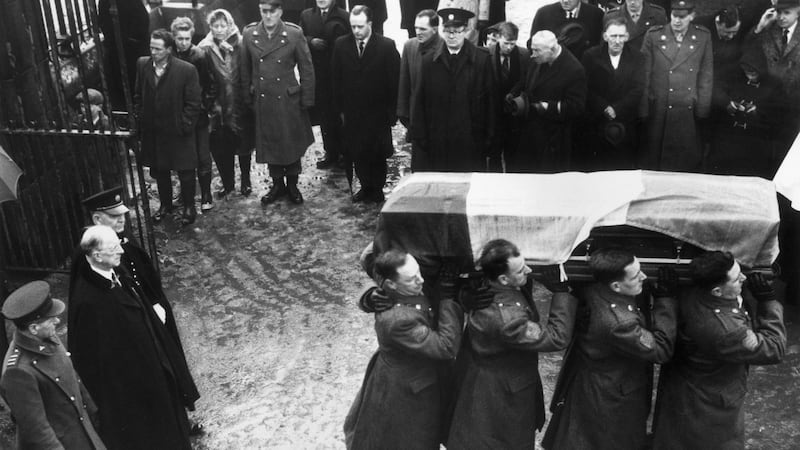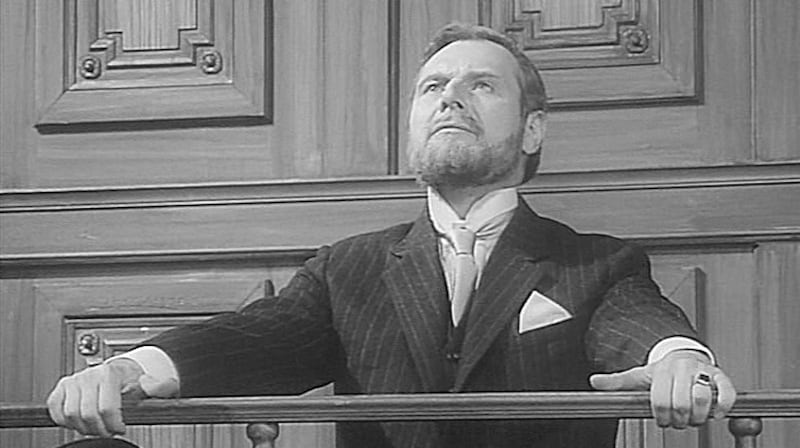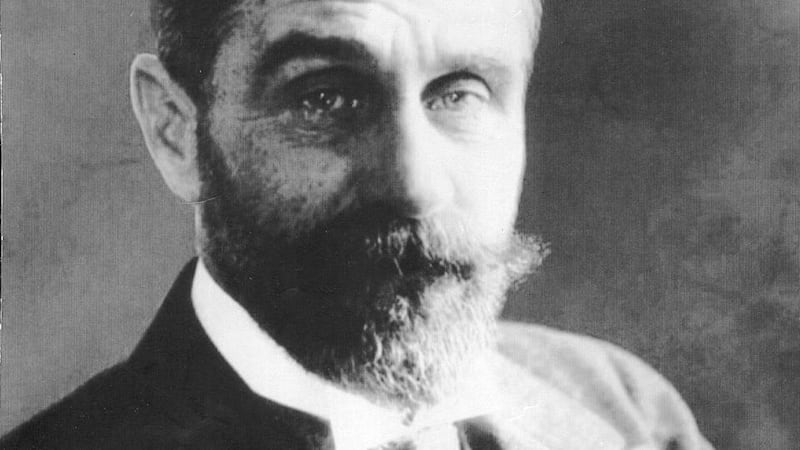A century after his execution for high treason, a version of Roger Casement remains buried, not in Pentonville prison or Glasnevin Cemetery, but in Mainz, Germany. But to explain how the Irish revolutionary turned up in this city 40 minutes from Frankfurt, we need to go back in time.
In February 2016, one David Kelly sent an email, asking to meet me during a visit he was making to Berlin. A few days later in an Italian restaurant Kelly, a London-based film producer with Irish parents, related in a low and urgent voice an unknown, posthumous episode in the life of Roger Casement.
A final deal was finally struck for 20,000 rifles that the Germans hoped would, in Irish hands, destabilise the British war effort
Given the Irish-born, British diplomat’s dramatic life and death, it was fitting that our conversation, with its conspiratorial air, took place in Berlin.
It was here, a century previously, that the Sandycove native had concluded his 18-month campaign to secure Imperial German support for the Irish freedom struggle. But his attempts to recruit Irish-born British prisoners of war to an Irish brigade had fizzled out, and German promises to deliver arms to Irish rebels were diminishing by the day.
A final deal was finally struck for 20,000 rifles that the Germans hoped would, in Irish hands, destabilise the British war effort.
The rifles were dispatched on a German boat in April 1916, sailing under a Norwegian flag, while Casement travelled separately to Ireland on a madcap journey via U-boat.
Things ended badly: the British intercepted the shipment, and the captain scuttled the ship and sank its contents. Casement was arrested shortly after arrival in Kerry, found guilty of treason and hanged in London’s Pentonville Prison on August 3rd, 1916.

It was an ignominious end for a complex figure whose early work as a lay missionary, to Africa and South America, became a life-long mission: to document and publicise the horrific conditions of slaves on rubber plantations in Congo and Peru.
Repatriation
David Kelly’s connection to Roger Casement began early. Growing up near Pentonville prison with Irish emigrant parents, Kelly remembers as a child the fuss over the exhumation and repatriation of Casement’s remains to Ireland in 1965.
“We knew about him and he always intrigued me, in particular when I learned he [had occupied] the same wing as George Best later,” says Kelly.
In 2014, with an eye on the looming anniversaries of the Easter Rising and Casement's execution, Kelly met Peruvian writer Mario Vargas Llosa, to discuss optioning the rights to Vargas Llosa's Casement novel, The Dream of the Celt.
The cast give it their all, particularly German actor Heinz Weiss, who plays the Irishman with contrary grandeur
When the rights proved too expensive for him, Kelly cast about for other ways into the subject. Two years ago he stumbled on The Tragedy of Sir Roger Casement, a two-part television play produced and screened by ZDF public television in West Germany in 1968. It had lain forgotten in the archives until Kelly came knocking.
He hopes to screen the film in Ireland. But first it would have to be digitised and subtitled, and some outstanding rights issues resolved. Germany’s state cultural authority, the Goethe Institut, has signalled a willingness to help with financing. In Ireland, Kelly has secured some official goodwill but no money.
Kelly has now launched a crowd-funding campaign to free Roger Casement from his solitary confinement in ZDF's Mainz archive.
So what is the film like? Very much a television play of its time: black and white, with basic production values, no soundtrack and scenes as creaky as the actors’ leather boots. But the cast give it their all, particularly German actor Heinz Weiss, who plays the Irishman with contrary grandeur.
The film opens with a well-fed Casement dressed in a white suit, seated in a wicker chair and looking very much like a Tennessee Williams character. Without much ado, Casement launches into an attack on Britain’s Asquith administration for the Bachelors Walk massacre of July 26th, 1914, that resulted in four fatalities and 38 casualties.
The three-hour, two-parter often groans under the weight of its lengthy, expository dialogue
“The British government alone carries responsibility for this bloodbath and cowardly murder of women and children,” declares Casement to assembled US journalists.

He then heads, via Norway, to Germany where Imperial German officials in uniforms and squeaky boots wonder aloud whether he is a British secret agent.
At the same time in London, meanwhile, British officials explain to each other how they have had Casement under close observation since long before his arrival in Germany.
Looming disaster
With little action to speak of, the three-hour, two-parter often groans under the weight of its lengthy, expository dialogue. But the screenplay has a clear dramaturgical line, portraying Casement, after his capture in Ireland, as the only man who can prevent looming disaster in the under-resourced Easter Rising.
In a few outdoor scenes the north German coast doubles – not very credibly – for north Kerry.
A sympathetic doctor examines the ailing Casement in Tralee prison and asks his friends afterwards whether he should pass on Casement’s warnings to cancel the Easter Rising. An atypically obedient Kerryman suggests doing nothing: “Those in Dublin know what they want, we can only obey.”
As in life, the television drama builds to the trial and the infamous “Black Diaries”, detailing Casement’s sexual adventures with local men during his Congo posting.
If we are tried as criminals and murderers, shot because our crime is loving Ireland more than our lives … then I am proud to be a rebel
In one scene Viscount Haldane, the former lord chancellor, confronts his successor over the diaries. They have no connection to the trial, he argues, adding that leaking documents of questionable authenticity is “unworthy of any tradition of British justice”.
“With this diary the jury is to be morally outraged and pressure exerted on the court,” argues the viscount.

But the trial concludes with a guilty verdict and ZDF’s Casement is allowed deliver a variation on his final, celebrated address.
“If we are tried as criminals and murderers, shot because our crime is loving Ireland more than our lives … then I am proud to be a rebel,” he says. “As long as justice is considered unjust it is better for men to fight and die, more honourable to be a rebel.”
In a final, death row scene, he pens his farewell letter: “Tomorrow ... I will die the death that I sought, and may God forgive my mistakes and judge only the goal of my actions: freedom for Ireland.”
The film ends with a short coda, noting the return of Casement’s remains to Ireland and assuring viewers that he was a crucial figure in Ireland’s fight for freedom.
Though the film’s creative team are all dead, ZDF staff today view the film as a high-water mark of early German television, commissioned with the aim of public education and without today’s ratings pressures.
Colonial struggles
The Casement film’s sympathetic portrait of the rogue diplomat is no surprise, says ZDF film producer Peter Huth, given Germany’s traditionally positive view of Irish colonial struggles.
“And when the film aired in 1968, public attitudes to liberation struggles and revolts was viewed more positively in Germany than, say, in the 1950s,” he added.
A century after Casement’s execution, and 52 years after his remains were repatriated, David Kelly says the case for exhuming ZDF’s Roger Casement film is clear: to broaden understanding of a man still hostage to the fortune of professional and hobby historians on both sides of the Irish Sea.
The Tragedy of Roger Casement offers a fresh take on a familiar figure
“It is refreshing to have a dramatic take from another country,” says the producer.
If Kelly gets the funding he needs to digitise and subtitle the film, he has offered to hand it over afterwards – at no charge – to the Irish film archives.
Beyond screening the German film in Ireland, he also sees potential for a new Casement production, co-financed by Ireland, Britain and Germany, or by a streaming service such as Netflix or Amazon.
A genuine historical curiosity, The Tragedy of Roger Casement offers a fresh take on a familiar figure, soon to get his own summer school and a statue in Dún Laoghaire.
“The time is right for this because a new generation is taking a fresh look at Casement,” says Kelly. “From his early embrace of human rights or his life as a study of gay culture and persecution by the law, Casement’s story still has so much relevance today.”












